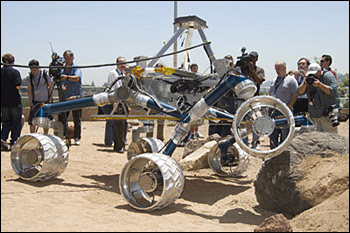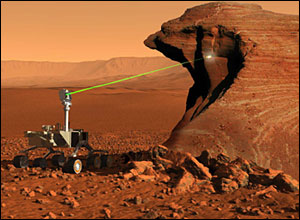
Next Rover $75M Over Budget
PASADENA, Calif., Sept. 18, 2007 -- In light of a Mars Science Laboratory budget overrun estimated at $75 million, NASA has cut off funding for some instruments, capped funding for others or eliminated them from the mission entirely. Among those no longer receiving space agency money is the ChemCam, a combination laser-telescope unit under construction at Los Alamos National Laboratory (LANL) that is more than 90 percent complete.

On June 19, 2007, members of the media visited the Jet Propulsion Laboratory’s newly expanded outdoor Mars Yard, where rovers train for future planetary missions, to watch a test drive of the "Scarecrow" version of the Mars Science Laboratory rover. The rover is missing its computer "brains" but showed it can still traverse large boulders. (Image: NASA/JPL-Caltech)
Scheduled to launch in the fall of 2009, the Mars Science Laboratory (MSL) project is part of NASA's long-term plan to remotely explore the red planet. The MSL, being built at the Jet Propulsion Laboratory (JPL) in Pasadena, will assess whether Mars has ever been able to support microbial life. It is much larger and heavier than the two Mars Exploration vehicles, Spirit and Opportunity, that have been roving the planet's surface since 2004.
A statement posted yesterday on the NASA Web site said a critical design review in early June of the project's $1.7 billion budget revealed a $75 million deficit. That discovery led the space agency to cut off additional funding for some instruments, remove the Mars Descent Imager (MARDI) and scale back the mission's scope in other areas.
The ChemCam instrument has two parts: a mast package and a body unit. On the mast is a telescope, connected fiber optically to the body unit, to focus its laser and camera; a laser for vaporizing surfaces and a remote microimager to acquire extremely detailed images. The mast package can be tilted or rotated as needed for optimum viewing of the rock.
ChemCam's remote sensing laser-induced breakdown spectroscopy (LIBS) instrument can provide data on the composition of rocks, pebbles and soil within 13 m of the rover.
Developing the ChemCam instruments for NASA with LANL is the space research laboratory Centre d'Etude Spatiale des Rayonnements (CESR) in Toulouse, France, with major contributions from JPL, Ocean Optics Inc. and CEA, France's Atomic Energy Commission.
LANL principle investigator Roger Wiens told the Los Alamos Monitor he received a phone call about the change Friday morning. "We're over 90 percent complete," he said..
The ChemCam instrument contains lasers to vaporize pieces of Martian rocks and spectrometers to identify their atomic elements. (Image: NASA/JPL-Caltech/LANL/J.-L. Lacour, CEA)
While NASA said it is no longer funding the ChemCam, it has also not removed it from the mission's science payload, and the space agency is reportedly looking to the project's other sponsors to provide the funds to finish the instrument.
Wiens told the Los Alamos Monitor that a French company has already delivered the laser, which has been under testing for several months. "Nothing technically has prompted this action," he said, adding that there are no immediate plans to scuttle the project. "Nothing is on hold with ChemCam. Given the closeness to the instrument delivery, everybody here wants to support us 100 percent. We're still moving ahead, and I think we will be on this mission," Wiens told the paper.
The MARDI was designed to take color video during the rover's descent toward the planet surface as a way to allow crews on Earth to select an exploration path for the vehicle and as well as tell them exactly where the MSL has landed. Those functions will be transferred to the Mars Reconnaissance Orbiter's HiRise camera now in orbit.
Other cost-saving measures include removing the 10X zoom capability on the mast camera, with those functions now being provided by the HiRise camera, and changing a rock grinding tool to a rock brushing tool.
Being capped at their current budgets are the x-ray diffraction/x-ray fluorescence instrument (CheMin) and the three-instrument sample analysis at Mars (SAM) suite, consisting of a mass spectrometer, a gas chromatograph and a tunable laser spectrometer.
Engineering changes include some reductions in design complexity, flight software simplifications, and ground test program changes, NASA said. No changes were made to the mission's science team at JPL.
"I am very pleased that we were able to resolve this challenge to the Mars program without delaying or canceling any other mission in the Mars program or other parts of SMD, and we avoided impacting research and analysis. We were also able to reduce some risks in MSL's development and flight," said Alan Stern, NASA's associate administrator for science, in NASA's statement.
"The MSL project, Mars program, JPL and NASA HQ worked together to constrain the impacts to the Mars program and keep MSL on schedule for its launch in 2009, and we all feel we succeeded," said Doug McCuistion, Mars program director, in the same statement.
For more information, visit: http://mars.jpl.nasa.gov/msl/
Published: September 2007